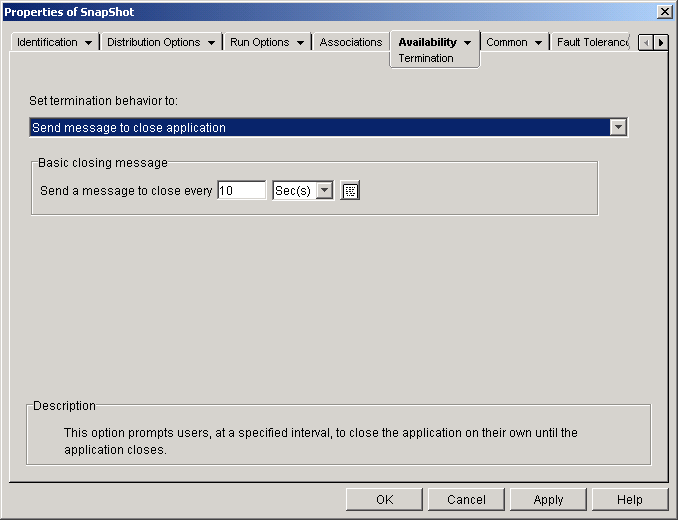
The Availability tab includes the following pages to help you determine the system requirements a workstation must meet before the application will be distributed to the workstation, the days and times the application will be available to users, and the messages and warnings Application Launcher/Explorer will display to users when terminating an application that has become unavailable to users:
The System Requirements property page, shown below, determines the system requirements a workstation must meet before Application Launcher/Explorer will distribute the application to it.
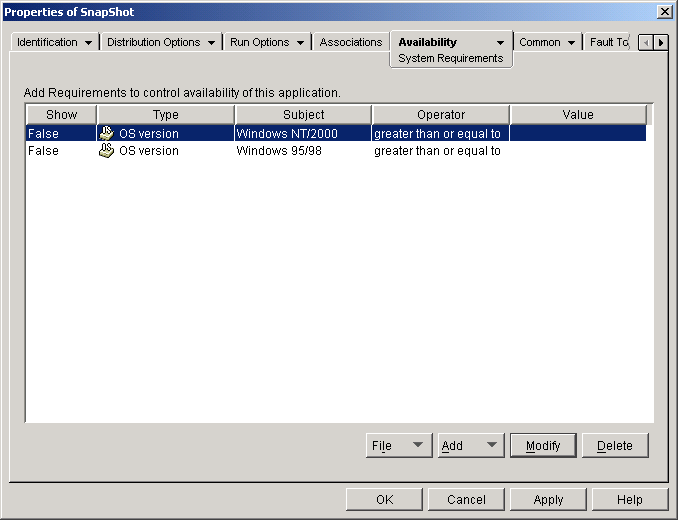
This list displays all the requirements associated with the distribution of the application. For each requirement, the following information is displayed:
Show: This column indicates if the Application object's icon will be displayed on the workstation regardless of whether or not the requirement is met. The icon will display in a disabled state if the requirement is not met.
If an icon is displayed in a disabled state, users can right-click the icon, select Details, then select Requirements in order to see which requirements were not met. They can then perform any necessary upgrades to the workstation configuration to meet the application requirements.
Type: This column shows the category of the system requirement. Categories are explained under Add below.
Subject: This column shows the subject of the system requirement. For example, if the type is OS Version, the subject could be Windows 95/98 or Windows NT/2000/XP.
Operator: This column shows if a condition (greater than, less than, equal to, etc.) must be met for the assigned value.
Value: This column shows if a value is associated with the subject. For example, if Windows NT/2000/XP is the subject, the version may need to be greater than or equal to 4.00.950 in order for the application to be distributed.
Click File > Find to search for requirements that include certain information. For example, you could search for requirements that include "Windows," "greater than," or "system memory."
Click File > Import to import requirements from another Application object.
Click this option to add a new system requirement, based on one of the following categories:
Applications: Require a specific application to be installed or not be installed. The application must have been distributed through an Application object. For more information, see Applications .
Disk Space: Require a specific amount of disk space on the workstation. For more information, see Disk Space .
Environment Variables: Require specific environment variables to be present or not present. For more information, see Environment Variables .
Memory: Require a specific amount of memory on the workstation. For more information, see Memory .
Operating System: Require a specific operating system. For more information, see Operating System .
Processor: Require a specific processor type. For more information, see Processor .
Registry: Require specific registry values to be present or not present. For more information, see Registry .
File Existence: Require a file to be present or not present. For more information, see File Existence .
File Version: Require a file to be a specific version. For more information, see File Version .
File Date: Require a file to be a specific date. For more information, see File Date .
File Size: Require a file to be a specific size. For more information, see File Size .
Select a requirement in the list > click Modify to edit the information.
Select a requirement in the list > click Delete to remove the requirement.
The Application Dependencies dialog box (System Requirements page > Add > Application) lets you create a requirement based on the existence, or nonexistence, of another application. Application Launcher/Explorer will not distribute the application to the workstation unless the requirement is met.
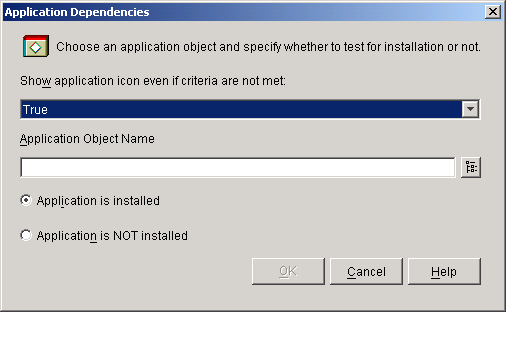
Select True to display the application icon on the workstation regardless of whether or not the requirement is met. The icon will display in a disabled state if the requirement is not met. Users can right-click the disabled application's icon, select Details, then select Requirements in order to see which requirements were not met. They can then perform any necessary upgrades to the workstation configuration to meet the application requirements.
Browse and select the appropriate Application object.
Select this option to indicate that the selected application must already be installed on the workstation.
Select this option to indicate that the selected application must not be installed on the workstation.
The Disk Requirements dialog box (System Requirements page > Add > Disk Space) lets you create a requirement based on the amount of disk space required by the application. Application Launcher/Explorer will not distribute the application to the workstation unless the requirement is met.
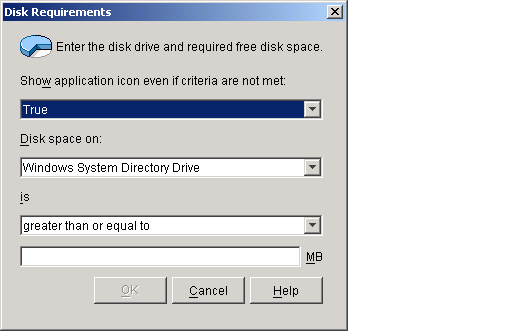
Select True to display the application icon on the workstation regardless of whether or not the requirement is met. The icon will display in a disabled state if the requirement is not met. Users can right-click the disabled application's icon, select Details, then select Requirements in order to see which requirements were not met. They can then perform any necessary upgrades to the workstation configuration to meet the application requirements.
Select the disk where you are requiring free space. The list includes the following options:
A through Z: Allows you to select the disk that is mapped to drive A, B, C, and so on.
Windows System Directory Drive: Allows you to select the disk where the Windows system directory (for example, WINDOWS\SYSTEM) resides.
Windows Directory Drive: Allows you to select the disk where the Windows directory (for example, WINDOWS) resides.
Windows Temp Directory Drive: Allows you to select the disk where the Windows temporary directory (for example, WINDOWS\TEMP) resides.
If you create multiple disk space requirements for the application, Application Launcher/Explorer adds the requirements together to determine the total disk space requirement. For example, if you specify 20 MB free on the Windows directory drive (which happens to be the C: drive), 10 MB free on the TEMP drive (which is also the C: drive), and 50 MB free on the D: drive, Application Launcher/Explorer distributes the Application object only if there is 30 MB available on the C: drive and 50 MB free on the D: drive.
Select whether the available disk space must be less than, less than or equal to, equal to, greater than, greater than or equal to the amount listed in the MB field. For example, if you want to require at least 50 MB of free disk space, select Greater Than or Equal To and then enter 50 in the MB field.
Enter the disk space requirement.
The Environment Variable System Requirements dialog box (System Requirements page > Add > Environment Variables) lets you create a requirement based on the existence, or nonexistence, of a specific environment variable. Application Launcher/Explorer will not distribute the application to the workstation unless the requirement is met.
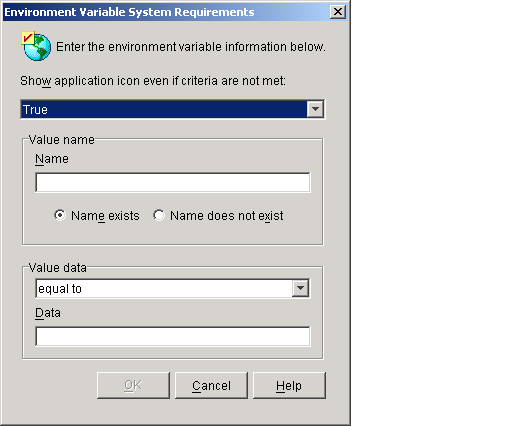
Select True to display the application icon on the workstation regardless of whether or not the requirement is met. The icon will display in a disabled state if the requirement is not met. Users can right-click the disabled application's icon, select Details, then select Requirements in order to see which requirements were not met. They can then perform any necessary upgrades to the workstation configuration to meet the application requirements.
Enter the name of the environment variable. Select the Name Exists option to require the variable to already exist on the workstation, or select the Name Does Not Exist option to require the variable to not exist on the workstation.
Specify whether the variable data must be equal to, not equal to, contain, or not contain the data you enter in the Data field.
The Memory Requirements dialog box (System Requirements page > Add > Memory) lets you create a requirement based on the amount of memory (RAM) required to run the application. Application Launcher/Explorer will not distribute the application to the workstation unless the requirement is met.
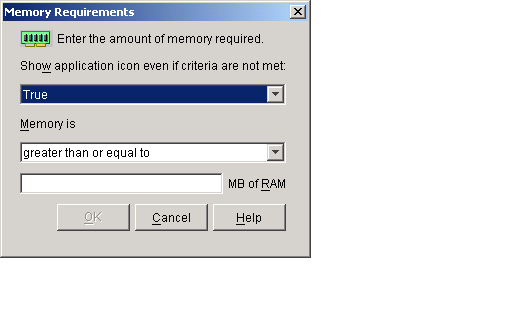
Select True to display the application icon on the workstation regardless of whether or not the requirement is met. The icon will display in a disabled state if the requirement is not met. Users can right-click the disabled application's icon, select Details, then select Requirements in order to see which requirements were not met. They can then perform any necessary upgrades to the workstation configuration to meet the application requirements.
Select whether the total memory must be less than, less than or equal to, equal to, greater than, greater than or equal to the memory entered in the MB of RAM field. For example, if you want to require at least 32 MB of free RAM, select Greater Than or Equal To and then enter 32 in the MB of RAM field.
Enter the required memory amount.
The Operating System Requirements dialog box (System Requirements page > Add > Operating System) lets you create a requirement based on the operating system required to run the application. Application Launcher/Explorer will not distribute the application to the workstation unless the requirement is met.
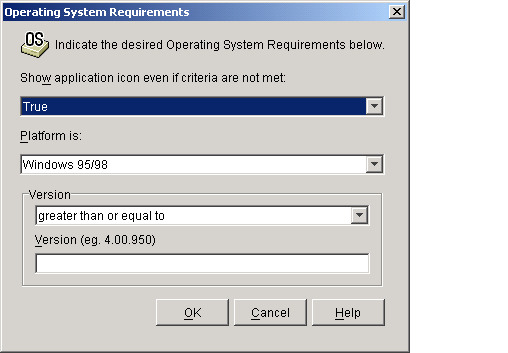
Select True to display the application icon on the workstation regardless of whether or not the requirement is met. The icon will display in a disabled state if the requirement is not met. Users can right-click the disabled application's icon, select Details, then select Requirements in order to see which requirements were not met. They can then perform any necessary upgrades to the workstation configuration to meet the application requirements.
IMPORTANT: With this option set to True, the application icon will be shown only if the operating system platform is the same as the one selected but the version does not meet the version requirement. For example, if you select Windows95/98 as the platform and enter greater than or equal to 4.02.1998 as the version, the icon will not display on a Windows NT/2000/XP workstation, will display in an active state on a Windows 98 workstation running version 4.02.1998 or newer, and will display in a disabled state on a Windows 95 workstation or a Windows 98 workstation running version 4.01.1998 or older.
Select the operating system (Windows95/98 or Windows NT/2000/XP) the workstation must be running.
Select whether the version number must be less than, less than or equal to, equal to, greater than, greater than or equal to the number entered in the Version field. For example, if you want to require at least version 4.00.95, select Greater Than or Equal To and then enter 4.00.95 in the Version field.
The Processor Requirements dialog box lets you create a requirement based on the processor required to run the application. Application Launcher/Explorer will not distribute the application to the workstation unless the requirement is met.
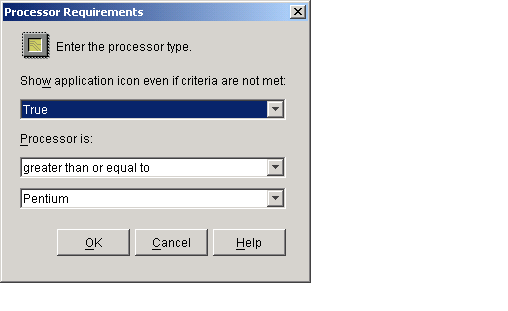
Select True to display the application icon on the workstation regardless of whether or not the requirement is met. The icon will display in a disabled state if the requirement is not met. Users can right-click the disabled application's icon, select Details, then select Requirements in order to see which requirements were not met. They can then perform any necessary upgrades to the workstation configuration to meet the application requirements.
Select whether the processor must be less than, less than or equal to, equal to, greater than, or greater than or equal to the processor type (386, 486, Pentium*, Pentium Pro, Pentium II, Pentium III) selected in the processor list. For example, if you want to require at least a Pentium II processor, select Greater Than or Equal To and then select Pentium II.
The Registry Requirements dialog box lets you create a requirement based on a specific registry key or value. Application Launcher/Explorer will not distribute the application to the workstation unless the requirement is met.
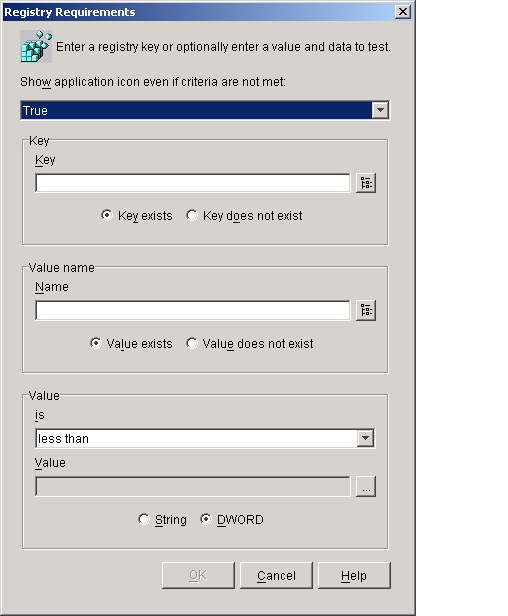
Select True to display the application icon on the workstation regardless of whether or not the requirement is met. The icon will display in a disabled state if the requirement is not met. Users can right-click the disabled application's icon, select Details, then select Requirements in order to see which requirements were not met. They can then perform any necessary upgrades to the workstation configuration to meet the application requirements.
Browse and select the registry key you want to check before distribution. Select Key Exists if the key must exist for the distribution to take place, or select Key Does Not Exist if the key cannot exist for the distribution to take place.
If the key has a specific value you want to check for, browse and select the value. Select Value Exists if the value must exist for the distribution to take place, or select Value Does Not Exist if the value cannot exist for the distribution to take place.
If you specified a value in the Name field, select a condition (less than, less than or equal to, equal to, not equal to, greater than or equal to, greater than) for the value's data > enter the data in the Value field > select whether the value data is a string or DWORD type.
The File Existence Requirements dialog box lets you create a requirement based on the existence, or nonexistence, of a specific file. Application Launcher/Explorer will not distribute the application to the workstation unless the requirement is met.
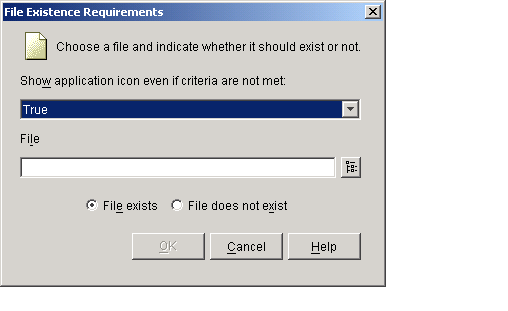
Select True to display the application icon on the workstation regardless of whether or not the requirement is met. The icon will display in a disabled state if the requirement is not met. Users can right-click the disabled application's icon, select Details, then select Requirements in order to see which requirements were not met. They can then perform any necessary upgrades to the workstation configuration to meet the application requirements.
Browse to select the file you want to search for.
Select this option to require the file to exist on the workstation.
Select this option to require the file to not exist on the workstation.
The File Version Requirements dialog box lets you create a requirement based on the version of a specific file. Application Launcher/Explorer will not distribute the application to the workstation unless the requirement is met.
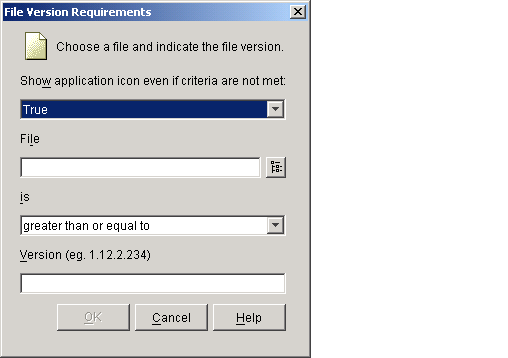
Select True to display the application icon on the workstation regardless of whether or not the requirement is met. The icon will display in a disabled state if the requirement is not met. Users can right-click the disabled application's icon, select Details, then select Requirements in order to see which requirements were not met. They can then perform any necessary upgrades to the workstation configuration to meet the application requirements.
Browse to select the file whose version you want to check.
Select whether the version must be less than, less than or equal to, equal to, greater than, greater than or equal to the version entered in the Version field. For example, if you want to require at least version 1.12.2.234, select Greater Than or Equal To and then enter 1.12.2.234 in the Version field.
Enter the file version.
The File Date Requirements dialog box lets you create a requirement based on the date of a specific file. Application Launcher/Explorer will not distribute the application to the workstation unless the requirement is met.
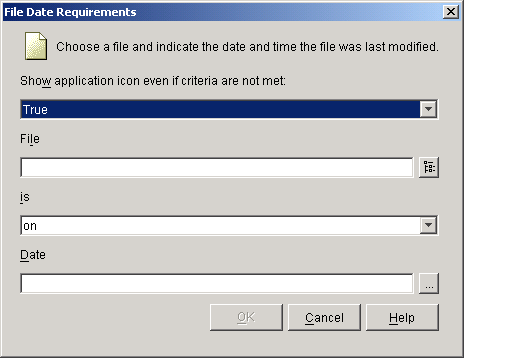
Select True to display the application icon on the workstation regardless of whether or not the requirement is met. The icon will display in a disabled state if the requirement is not met. Users can right-click the disabled application's icon, select Details, then select Requirements in order to see which requirements were not met. They can then perform any necessary upgrades to the workstation configuration to meet the application requirements.
Browse to select the file whose date you want to check.
Select whether the file date must be before, on or before, on, on or after, or after the date entered in the Date field. For example, if you want to make sure the application is distributed only if the file is dated 15 January 2000 or older, you would select On or Before and then select the date.
Use the Calendar to select the appropriate date and time.
The File Size Requirements dialog box lets you create a requirement based on the size of a specific file. Application Launcher/Explorer will not distribute the application to the workstation unless the requirement is met.
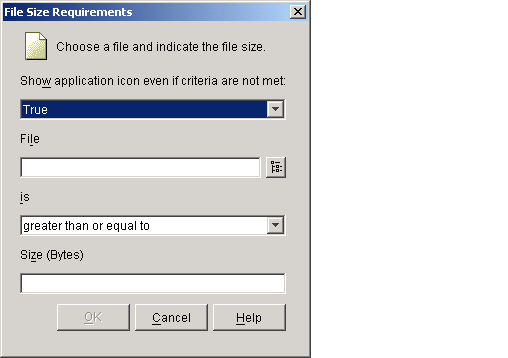
Select True to display the application icon on the workstation regardless of whether or not the requirement is met. The icon will display in a disabled state if the requirement is not met. Users can right-click the disabled application's icon, select Details, then select Requirements in order to see which requirements were not met. They can then perform any necessary upgrades to the workstation configuration to meet the application requirements.
Browse to select the file whose size you want to check.
Select whether the size must be less than, less than or equal to, equal to, greater than, or greater than or equal to the size entered in the Size field. For example, if you want to require the file to be at least 200 KB, select Greater Than or Equal To and then enter 200 in the Size field.
Enter the file size in kilobytes.
The Schedule property page, shown below, defines the dates and times when Application Launcher/Explorer will make the Application object available to users.
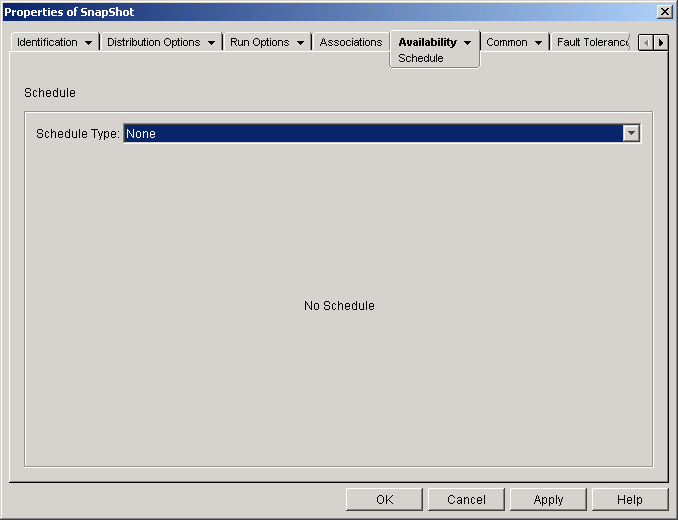
Select the type of schedule you want to use. You can choose None, Specified Days, or Range of Days.
Use this option to indicate no schedule. The Application object becomes available to an object as soon as the application's system requirements have been established (Availability > System Requirements page) and the application has been associated with the object (Associations page).
Use this option to select specific dates when you want the Application object to be available. You cannot select more than 350 specific dates.
Date Range: The Date Range list displays all dates when the Application object will be available. To add a date, click Add > select the date you want > click OK to display it in the list.
Times for Selected Dates: Select the availability start time and end time. The times apply to all dates in the Date Range list.
Spread from Start Time (in Minutes): Enter a number of minutes between available times if you don't want all users to run the application at the same time for fear of overloading the network. The spread option spreads out user access times over the number of minutes specified so they don't all run the application at once.
Use this option to select a range of dates to make the application available. You can also use this option to make applications available only on certain days of the week within a given range of dates.
Date Range: To define the range of days, select a start date and an end date, then select the days (Sunday through Saturday) within the established date range that the application will be available. By default, all days are selected; a day is selected when the button is depressed.
Times for Selected Range: Select the availability start time and end time. This option works differently depending on whether you selected one day or multiple days. If you selected one day, the application will be available between the start and end times on that day. For example, if you make the application available on Monday between 8:00 and 5:00, it will run between 8:00 and 5:00. However, if you make the application available Monday through Saturday between 8:00 and 5:00, the times are ignored. The application will be available Monday through Saturday, 24 hours a day.
Spread from Start Time (in Minutes): Enter a number of minutes between available times if you don't want all users to run the application at the same time for fear of bringing down the network because of the load and traffic.
Use the Schedule in GMT for All Clients: The schedule is based on the workstation's time zone. If your network spans different time zones and you schedule an application to run at 1:00 p.m., it runs at 1:00 p.m. in each time zone. You can select this option to have workstations run applications at the same time regardless of their time zones (for example, 1:00 p.m. Rome time and 11:00 p.m. Los Angeles time.
The Termination property page, shown below, determines how Application Launcher/Explorer terminates the application if it becomes unavailable to a user while the user is running the application. An application becomes unavailable to a user when:
Select the behavior you want used when the application terminates.
Select this option to disable any termination behaviors.
This option causes Application Launcher/Explorer to display a message instructing the user to close the application. The message appears periodically until the user closes the application.
In the Basic Closing Message box, select how often you want Application Launcher/Explorer to display the message. The following default message will be used unless you click the Message button and define a custom message:
WARNING! Your access to this application has expired. Please close the application to avoid losing your work.
This option causes Application Launcher/Explorer to first display a message instructing the user to close the application. If the user does not close the application, Application Launcher/Explorer sends a call to the application instructing it to close. If the user has no unsaved data, the application closes immediately. If the user has unsaved data, the application displays a Save dialog box to allow the user to save the data. After the application closes, users cannot launch it again.
IMPORTANT: Some applications display a Save dialog box that includes a Cancel button in addition to Yes and No buttons. The Cancel button aborts the close operation and the application remains open. If the application's Save dialog box includes a Cancel button and you want to ensure that the application is closed, you must use the Send Message to Close, Prompt to Save, Then Force to Close option.
Warning Message (Optional): Check the Send Warning option if you want to warn the user to close the application, then enter the number of times to display the warning message and the interval between messages. The following default message will be used unless you click the Message button and define a custom message:
WARNING! Your access to this application has expired. Please close the application to avoid losing your work.
Prompt Closing Message: This message is displayed if the user does not close the application after receiving the warning message the specified number of times, or if the warning message option is not enabled.
In the Prompt Closing Message box, enter how often you want to prompt the user to close the application. If, after receiving the prompt, the user does not close the application, Application Launcher/Explorer attempts to close the application. The following default message will be used unless you click the Message button and define a custom message:
WARNING! Your access to this application has expired and the application will close shortly. Please save your work and exit the application.
This option causes Application Launcher/Explorer to first display a message instructing the user to close the application. If the user does not close the application, Application Launcher/Explorer sends a call to the application instructing it to close. If the user has no unsaved data, the application closes immediately. If the user has unsaved data, the application displays a Save dialog box to allow the user to save the data. Regardless of the option (Yes, No, Cancel) the user selects, the application is closed.
Warning Message (Optional): Check the Send Warning option if you want to warn the user to close the application, then enter the number of times to display the warning and the interval between warnings. The following default message will be used unless you click the Message button and define a custom message:
WARNING! Your access to this application has expired. Please close the application to avoid losing your work.
Prompt Closing Message: This message is displayed if the user does not close the application after receiving the warning message the specified number of times, or if the warning message option is not enabled.
In the Prompt Closing Message box, enter how often you want to prompt the user to close the application. If, after receiving the prompt, the user does not close the application, Application Launcher/Explorer attempts to close the application. The following default message will be used unless you click the Message button and define a custom message:
WARNING! Your access to this application has expired and the application will close shortly. Please save your work and exit the application.
Application Termination: This message is displayed after Application Launcher/Explorer closes the application. If you don't want to use the default termination message, click the Message button and define a custom message. The default message is:
The application you were running has expired. For additional usage, please contact your system administrator.
This option prompts the user to close the application. If the user does not, Application Launcher/Explorer closes the application automatically and displays a termination message.
Warning Message (Optional): Check the Send Warning option if you want to warn the user to close the application, then enter the number of times to display the warning and the interval between warnings. If the user does not close the application, Application Launcher/Explorer closes the application automatically after the last warning message. The following default message will be used unless you click the Message button and define a custom message:
WARNING! Your access to this application has expired. Please close the application to avoid losing your work.
Application Termination: This message is displayed after Application Launcher/Explorer closes the application. If you don't want to use the default termination message, click the Message button and define a custom message. The default message is:
The application you were running has expired. For additional usage, please contact your system administrator.